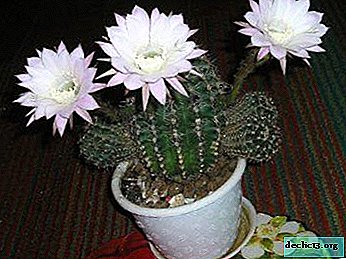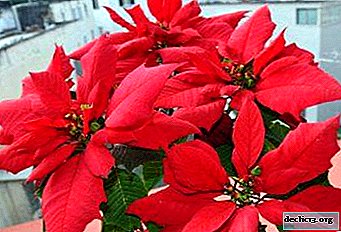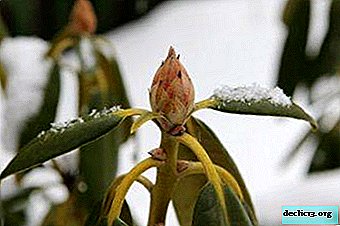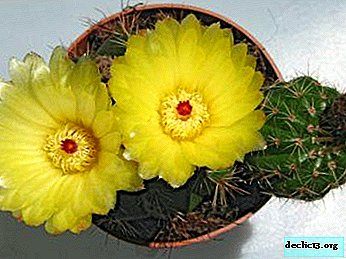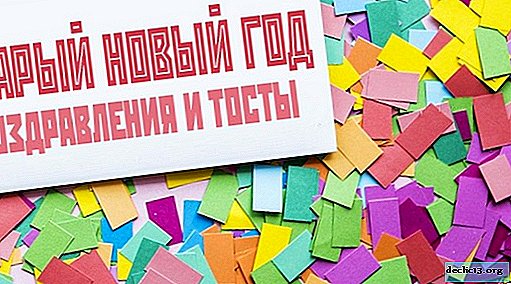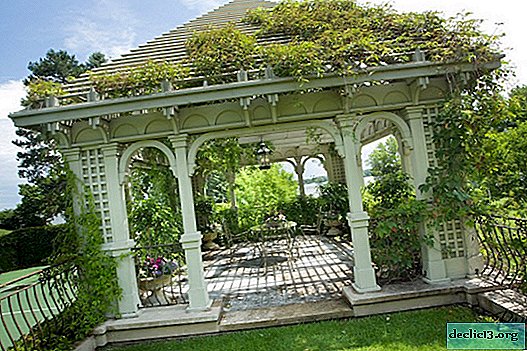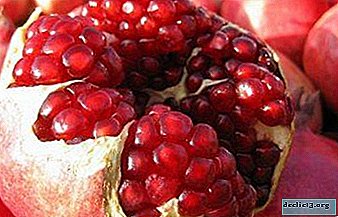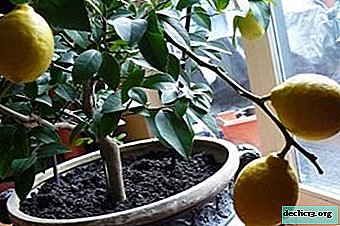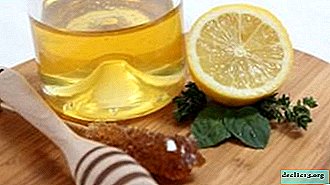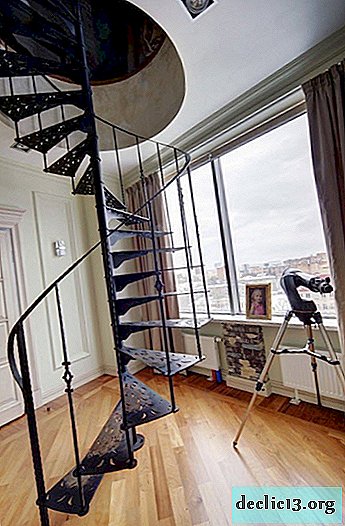Pest on the currant bushes. How to deal with gall aphids?

When uncontrolled reproduction of aphids causes great damage to the yield of currants.
It is impossible to completely get rid of this pest in the garden. In order to protect the plantings as much as possible, it is important to treat them with the right drugs at the right time.
To do this, you need to understand the biology of the insect, especially the cycle of its development and reproduction.
Type of parasite infecting bushes
In total, 20 species of aphids are known, which parasitizes on currants and gooseberries. In our latitudes there are 13 species that inhabit leaves, bark, young shoots, peduncles, berries, and even shrub roots.
Green and black aphids are widespread, but gall leaf inflicts especially strong damage.Gall sheet
With the defeat of this pest, specific symptoms appear:
- the damaged leaf grows, dark red or yellow swellings - galls form on the upper side;
- colonies of aphids appear on the underside;
- the tops of the shoots twist, sometimes they dry out.
 Gall aphids are most active on red and white currants, while black and golden ones are affected to a much lesser extent. This pest prefers young shoots with a thin skin on the leaves, but can populate the entire bush, if the measures for destruction are not taken in time. At high temperatures, the reproduction of the parasite is more intense.
Gall aphids are most active on red and white currants, while black and golden ones are affected to a much lesser extent. This pest prefers young shoots with a thin skin on the leaves, but can populate the entire bush, if the measures for destruction are not taken in time. At high temperatures, the reproduction of the parasite is more intense.
Features:
- An individual gall leaf aphid reaches a length of 3 mm.
- The body is painted in a dull green-yellow color, covered with microscopic hairs.
- In appearance it resembles green aphids, but the latter does not lead to the formation of galls on the leaves of currant.
What damage is done?
The aphid primarily affects young shoots, piercing the surface of the leaves and eating the juice of the plant. To tighten the puncture sites, currants produce a special tissue similar to a growth. The healthy structure of the leaf is broken, photosynthesis slows down, and the plant receives less energy for the growth of shoots and ripening of berries.
Damaged branches will not be able to fully bear fruit in the next year and much harder to tolerate an unfavorable period. The overall productivity and winter hardiness of the stands is reduced.
Gall aphids carry grouse virus, which is much more difficult to deal with than pests.Where and why does it appear?
Aphids appear in early spring from eggs laid for winter in the bark of branches currants, closer to the kidneys. The first individuals hatch when the buds swell or the appearance of the first leaves. These are the founder aphids, each of them is able to give birth to more than a hundred female descendants, without wings. When the colony becomes too large, winged individuals appear, flying over to neighboring bushes and other suitable plants.
At the end of the summer, males and females begin to return to the currant bushes for mating and laying eggs. The masonry withstands severe frosts and remains in the crust for up to 250 days until a favorable period arrives. Aphids can also lay eggs on weeds near fruit plantations, so it appears on the site, even when the currant is carefully processed, but the weeds are not removed.
How to deal: how to treat the plant in the spring?
Spring measures to combat gall aphids on currants include 3 stages:

- Early spring processing. It is necessary for the destruction of eggs wintering in the bark. Before the first leaves appear, the currant must be treated with hot water. The bush is watered from a watering can with boiling water. If the buds have already blossomed, hot water can not be used, it will damage the shoots.
It is better to use special drugs, for example, 30-B, Prophylactin. These are universal means for the destruction of wintering forms of parasites of different cultures.
- Processing before flowering. After the leaves bloom, when the founding aphids and small colonies appear, insecticides can be used. The aphid breeding peak occurs during the flowering period of currants, but it is better to carry out the treatment in advance so as not to harm the bees and other pollinators. To combat aphids during this period, you can:
- remove damaged shoots;
- apply folk recipes;
- spray the bush with chemicals;
- use biological products.
- Spraying. You must also know how to spray the bushes during flowering. You can not treat the flowering currant with insecticides, especially systemic ones, since toxins can accumulate in the berries. During this period, it is better to use alternative recipes against aphids or biodegradable biological preparations.
Cutting off infected leaves helps in cases where there are few pests. But the obvious symptoms of damage - galls - appear when the aphid colony reaches a large size, capable of resettlement. If most of the bush is affected, removing the shoots is impractical.
Popular folk recipes against aphids:
- Marigold Flask. Half fill the 10-liter container with chopped flowers and stems, pour water to the top. Insist 2 days in a cool place, strain, add 40 g of laundry soap. The infusion is ready for spraying.
- Tobacco infusion. 200 g of dry leaves pour 5 l of cold water, leave for 2 days. Add another 5 liters of clean water, strain and use for spraying.
- Soap solution. Dissolve 300 g of laundry soap in 10 l of water. Water the bush with plenty of solution. Laundry soap can be replaced with liquid cosmetic, which will require half as much.
What drugs to use to get rid of the pest?
 Treatment with drugs is carried out in dry, calm weather, using personal protective equipment and strictly adhering to the instructions. The best time is early morning or late evening.
Treatment with drugs is carried out in dry, calm weather, using personal protective equipment and strictly adhering to the instructions. The best time is early morning or late evening.
In spring, spraying is carried out immediately after pruningto protect fresh slices from infection.
After buds bloom and before the currant blooms, chemical insecticides can be used to kill aphids. They are quite effective, but pests can adapt to them, so the funds alternate.
Systemic drugs are absorbed by the plant and through the proboscis enter the intestine of the pest, causing its death. Against aphids effective:
- Actara.
- Confidor.
- Tanrek.
- Biotlin.
Of non-systemic drugs, you can use the following:
- Spark.
- Inta Vir.
- Inta-S-M.
- Herald.
- Fufanon.
- Kinmix.
If inflorescences have already formed on the currant, it is better to use biological preparations to destroy parasites. They penetrate the body of the pest with the juice of the plant, cause intestinal damage, paralysis, death. Such funds are considered relatively harmless to humans, since they are based on natural substances. Among them:
- Bitoxibacillin.
- Actofit.
- Aversectin S.
- Haupsin.
Which insect saves bushes?
 Aphids feed on predatory bugs, thrips, ladybugs, ground beetles and other insects. The main assistant to the gardener is a ladybug. Its larvae eat colonies and quickly heal currant bushes, although they themselves look somewhat intimidating.
Aphids feed on predatory bugs, thrips, ladybugs, ground beetles and other insects. The main assistant to the gardener is a ladybug. Its larvae eat colonies and quickly heal currant bushes, although they themselves look somewhat intimidating.
In order for the ladybug to freely destroy aphids, ants need to be removed from the garden plot. The latter specifically “grow” aphids, being in symbiosis with it: protecting colonies in order to use them as a source of “milk”. Aphids suck out a large amount of juice from currants, not having time to absorb all its nutrients, so its excretion is sweet, which is what ants use.
To destroy anthills, use boiling water, hot vinegar or special preparations.
Preventative measures
Prevention of the appearance of aphids on currants should begin in the fall, after all leaves have fallen from the bush. Litter should be removed and burned, and the shoots treated with special means to destroy the eggs of pests, such as Nitrafen. Particular attention should be paid to damaged bark and areas with kidneys.
In early spring, it is better to mulch the land around the shrub. It is important to remove weeds on time. Near the currant stands should not be planted:
- peppermint;
- sage;
- thyme;
- lavender;
- oregano;
- cleaner.
On them, the gall aphid migrates in mid-summer, when the leaves of the currant become too stiff. These cultures are suitable for further reproduction of the pest - a generation of heterosexual individuals appears on them, which return to the currant bushes and lay eggs.
Chamomile, marigolds and calendula scare away pests with a specific smell. They can be planted in row spacing.To maximize the protection of currants from aphids, it is important to combine methods of combating and preventing it, as well as monitor plants located near the bush. Especially important is the spring period when aphid colonies only appear, and chemical treatment is possible.
Useful video
We offer you to watch a video about methods of combating aphids on currants:

